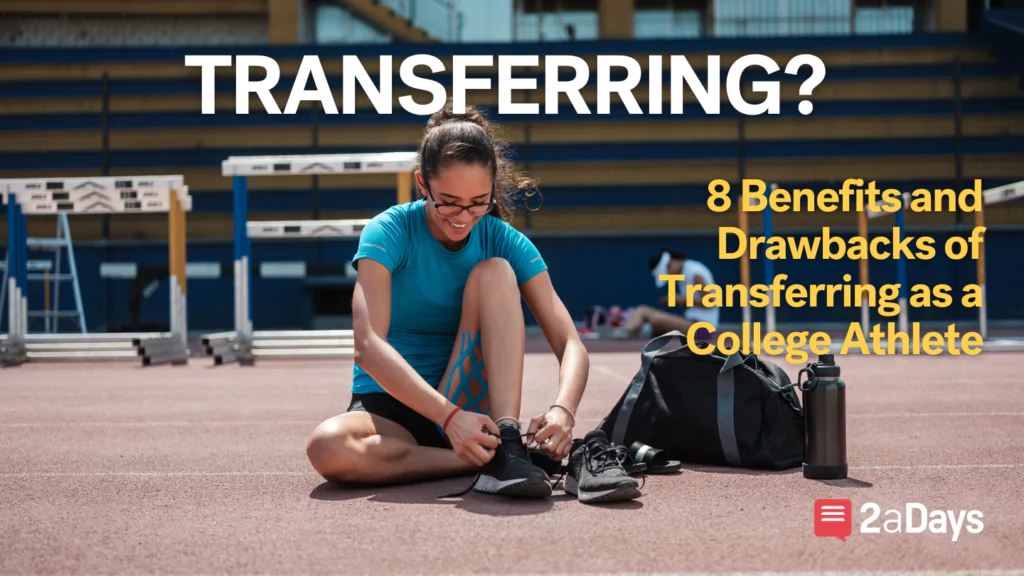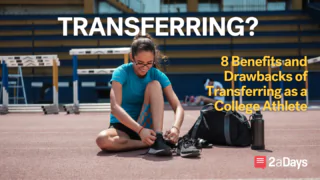Transferring colleges is easier than ever for a college athlete. Although a simple process, the decision of whether or not to transfer should not be taken lightly and deserves extensive thought. Is transferring the right decision for you?
Here are eight benefits and drawbacks of transferring as a college athlete:
Benefit #1: Life Changing Experience
Transferring to a new school is going to be a totally new experience that will change an athlete's life. Oftentimes, athletes will transfer because they are unhappy at their current school, regardless of if it has to do with athletics. The opportunity to transfer could significantly improve their quality of life and wind up being a decision they are incredibly grateful that they made.
Benefit #2: More Playing Time
Sometimes, athletes will find themselves in a situation where they aren't playing as much as they hoped or as much as they had been promised. This can be due to a coaching change, a new superstar recruit, or a couple bad performances resulting in them moving down the roster. Transferring can allow athletes to find a place where they can get back to playing as much as they previously had been or expected.
Related: Rate your Coaches, Facilities, and Campus Visits
Benefit #3: Playing at a Higher Level
Not every athlete is a top ranked recruit coming out of high school. If an athlete arrives at a school that isn't a nationally ranked or recognized team but proves how well they can perform in college competition, transferring can provide them the opportunity to play at a higher level.
Benefit #4: Potential Increase in NIL opportunities
Name, image and likeness is one of the hottest topics in college sports right now. By transferring, a player may be able to head to a school that is in a location with a better market for them to profit off their NIL. This includes both superstar athletes transferring to bigger markets and lesser known athletes heading to areas where they can thrive in the NIL sphere.
Related: Pros and Cons of NIL
Benefit #5: Easier Transfer Process
Since the implementation of the transfer portal in 2018, transferring has never been easier. Rather than needing approval from a coach to transfer to a new school, college athletes can now be placed in the transfer portal at their own discretion and not worry about being denied the chance to play elsewhere.
Related: Recruiting FAQs: What is the Transfer Portal?
Benefit #6: Immediate Eligibility
Recent NCAA rules have granted first-time transfer athletes the ability to immediately partake in competition upon transferring to a new school. This is incredibly beneficial for transfer athletes compared to before April 2021, when all transfer athletes were forced to spend an academic year in residence before participating in games.
Benefit #7: Better Chance at a Championship
There are times when a college athlete would like to win a championship for their school while competing in college. There are also times when athletes find themselves on teams where at the present time, there is little hope to achieve that goal. Transferring allows athletes to have the opportunity to position themselves on teams that have a better chance of winning a championship, regardless of the competition level relative to the original school.
Benefit #8: Better Mental Health
Athletes can find themselves struggling with their mental health in certain environments, regardless of whether it has to deal with their athletic circumstances. Transferring offers athletes the chance at a fresh start, which can drastically improve their mental health in some situations.
Drawback #1: Entering an Unfamiliar Environment
Transferring can be a scary experience. Athletes who transfer leave the place that they have lived, the routine they followed, and the friends that they have made. This can be extremely tough on an individual.
Drawback #2: Potential to Lose Credits
Just because athletes get to remain on a sports team when transferring doesn't necessarily mean that all of their credits will transfer. This could result in the athlete taking longer to graduate than initially expected, which could be an issue depending on their financial situation.
Drawback #3: Loss of Scholarship
Transferring to a new team may result in the loss of athletic financial aid for some athletes depending on the current scholarship status of that new team. This can be the case if the new team has already promised all of its allotted scholarship money to other players. Furthermore, if an athlete enters the transfer portal but changes their mind and returns to the same school, that school can revoke their scholarship and can even cut the player from the team.
Related: 5 Transfer Portal Tips
Drawback #4: Competition in the Transfer Portal
Because of the novelty and convenience of the transfer portal, there are thousands of athletes who utilize it every year. This can create a very competitive environment for athletes in the portal, as they are competing for roster spots with other transfers, incoming freshmen and players who are not transferring. In fact, half of all athletes who enter the transfer portal each year do not end up attending another school. This competition can result in transferring and losing playing time or not getting any new offers, which can lead to the loss of scholarships as mentioned above.
Drawback #5: Lower Team Chemistry
When an athlete stays at a school for all four years, and most of the turnover is athletes graduating and freshmen coming in, team chemistry is high due to the same core group being together for multiple years. Transferring to a new team forces the chemistry athletes have with their teammates to disappear and start fresh, both among the existing players and the transferring players.
Drawback #6: One-Time Transfer Rule
In the NCAA, you are only granted immediate eligibility following your first time transferring. That means that if an athlete is unhappy after transferring, they are stuck on their new team or have to enter the transfer portal again and complete an academic year in residence following their second transfer.
Drawback #7: Limited Time Remaining
Even if a college athlete transfers after just one season, that means they only get to be a part of their new team for three more. If the college athlete winds up having an incredible experience at their new school, it could leave them wishing that they had more time to play there or that they had gone to that school from the start.
Drawback #8: Strained Relationships
When an athlete decides to transfer, even if it is in their best interest, some of the people they leave behind at their old school may be upset. This could result in tension between the athlete and people who used to be their teammates, coaches or fans.
Have an idea for a story or a question you need answered? Want to set up an interview with us? Email us at [email protected]
* Originally published on June 21, 2023, by Owen Roche







